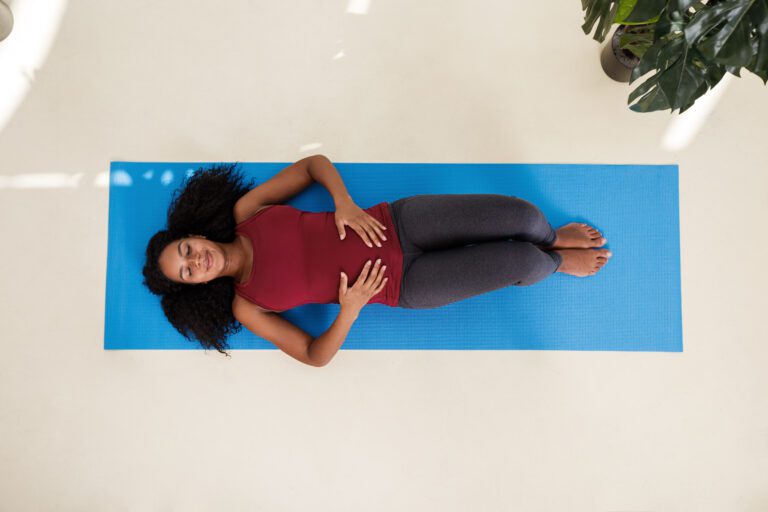Aren’t our bodies amazing? We can make, birth, and feed a whole new person! And as such, it’s important to honor ourselves by investing in a full recovery and healing after birth so we can live our best lives with our growing families.
This means taking time to strengthen the pelvic floor and abdominal muscles (core) that have worked hard to support your growing baby. And the earlier you start, the better. While it’s important to wait until about 6 weeks before resuming any intense exercise regimen, here are a few exercises you can resume immediately after giving birth—after you’ve celebrated with lots of snuggles and a good meal, of course!
Strengthening Pelvic Floor Muscles
Your pelvic floor muscles form the base of your “core.” Stretching from your pubic bone in the front to your tailbone in the back, and to the sit bones on your right and left sides, these muscles work with your deep abdominal muscles and your back to support your spine and control pressure in your abdomen.
Over the course of your pregnancy, your pelvic floor muscles support the ever-increasing weight of your growing baby. Then during birth, these same muscles stretch to birth your baby. After all this work, if we don’t strengthen them again during postpartum, we’re at increased risk for many common pelvic floor problems, including loss of bladder or bowel control (incontinence) and either painful or less pleasurable sex.
Abdominal Muscle Exercises
Your abdominal muscles (abs) form a corset that stabilizes your pelvis and supports your back; they’re essential to maintaining proper posture. In the same way that pregnancy stretches your pelvic floor muscles, your uterus, growing in size with your growing baby, pushes outward on the vertical abdominal muscles running down the middle of your stomach, making them longer and weaker.
Oftentimes, they will separate and pouch out. This condition is called diastasis recti and affects about 60% of women during pregnancy and postpartum. Normally, your separated stomach muscles will go back to their pre- pregnancy size within 8 weeks. But when they don’t, you’re more likely to experience long-term back pain and have a harder time getting your pre- pregnancy figure back.
Pelvic Floor Exercises
Pelvic floor exercises, previously known as “Kegels,” can strengthen the pelvic floor muscles around your bladder, vagina, and bottom. These exercises can reduce your risk of incontinence and help to assure that sex (after 6 weeks, of course!) feels satisfying again. Kegels can be done anywhere and anytime, while lying down, sitting, or standing.
- Find a comfortable position. At first, it may be easier to start lying down.
- Squeeze the muscles around your bottom as if you’re trying to hold in gas.
- Squeeze the muscles around your vagina and bladder as if you’re trying to stop the flow of urine.
- Aim to hold the squeeze for 10 seconds, rest for 10 seconds, and repeat up to 10 times. If this is difficult, perform short squeezes for 1 second, with a 1 second rest. Repeat 10-15 times.
- Don’t perform Kegel exercises with a full bladder.
Start gently, stay within your comfort zone, and work up to stronger exercises when you can. Try to do these exercises at least 3-4 times daily. In the beginning you may find it difficult to feel your pelvic floor muscles working. It can take a few weeks to build their strength back up. But stick with it and soon you’ll notice a difference and feel your pelvic floor muscles contracting and relaxing.
It can be challenging to remember to do pelvic floor exercises at first, so try to make them a part of your daily routine by prioritizing them the same way you prioritize brushing your teeth. Make time while you’re in the car, resting in bed, watching TV, feeding or cuddling your baby, or any other times that work for you.
Gentle Abdominal Exercises
These gentle abdominal exercises can reduce the size of the separation of your abdominal muscles to help your body bounce back more quickly and completely and reduce your risk of chronic back pain.
- Lie down, sit, or stand. Keep your back flat.
- Take a deep breath in, and on the exhale, pull your lower abdomen in towards your spine. Try not to bear down while you do this.
- Hold for a count of 10, then gently release.
- Repeat up to 10 times.
Once the gap in your abdominal muscles has closed and your pregnancy care provider gives you the “all clear” to resume more strenuous exercise, you can progress to more challenging workouts with crunches, sit-ups, planks, or Pilates.
Get Moving Early with Exercise, But Take it Slow
Once you feel ready, you can add other very low impact exercises, such as gentle yoga and short daily walks. This can add to your overall sense of wellbeing while improving circulation and helping to stretch out all of the sore spots as you recover from childbirth.
In addition to these exercises, take care to practice good posture, support your lower back with a pillow while sitting, and support yourself with your arm when getting out of bed or off of the floor.
Need More Help? If you still notice a bulge in your stomach, leaking urine, or pain with sex at 8 weeks post-birth, reach out to your provider and ask if you might be a good candidate for pelvic floor physical therapy. You deserve to have an intact body that functions beautifully, especially after all the work you’ve put into bringing your gorgeous baby into the world!
YOU MAY ALSO LIKE: Strategies for a Comfortable Postpartum Recovery






Comments are closed.